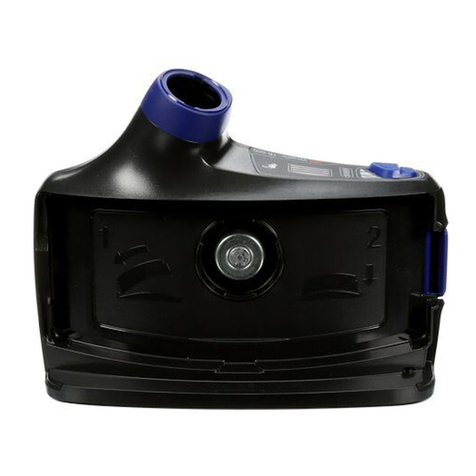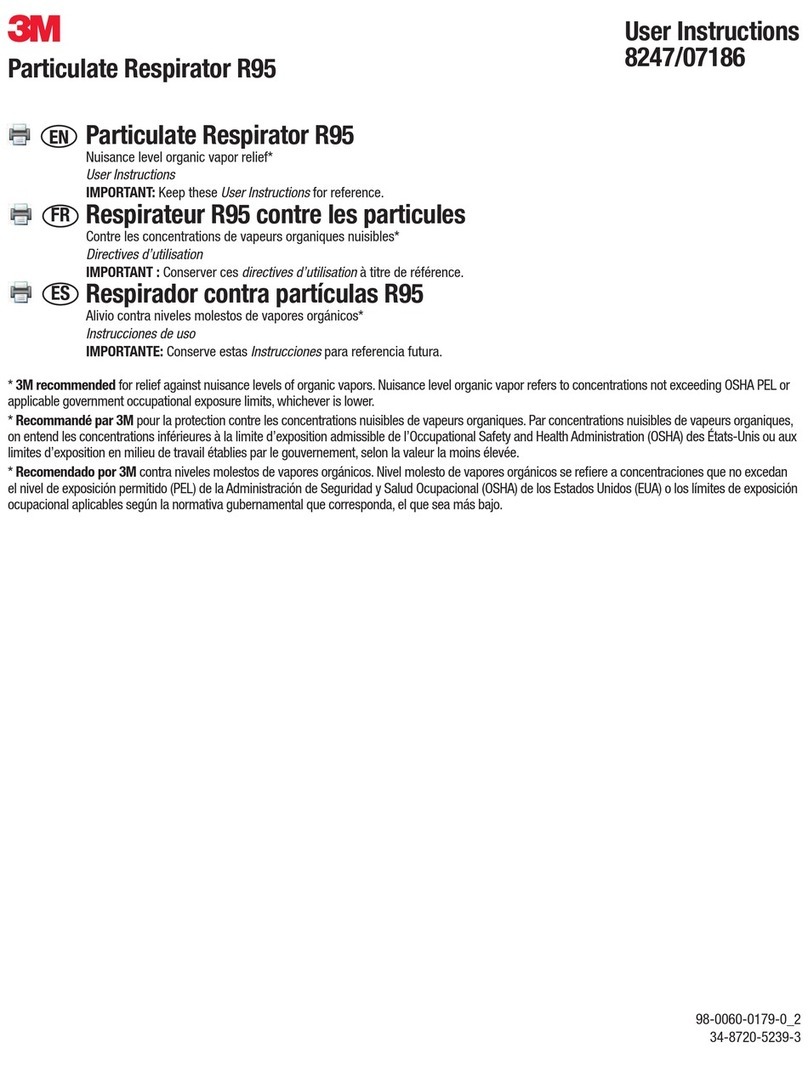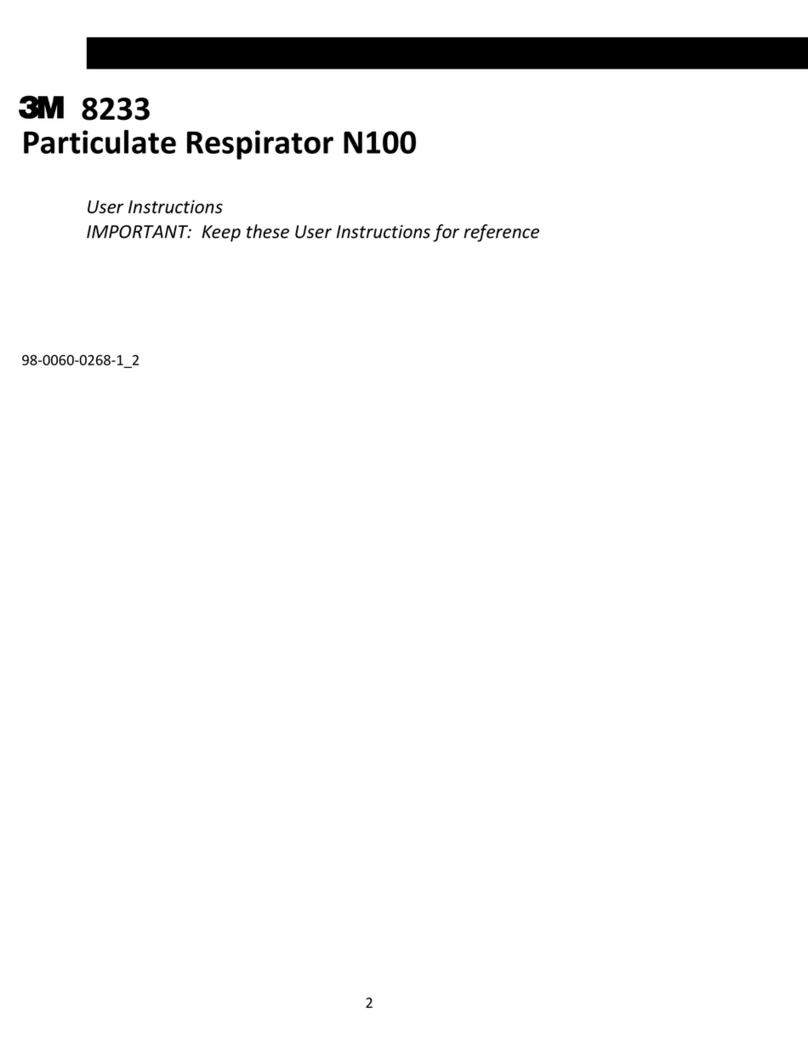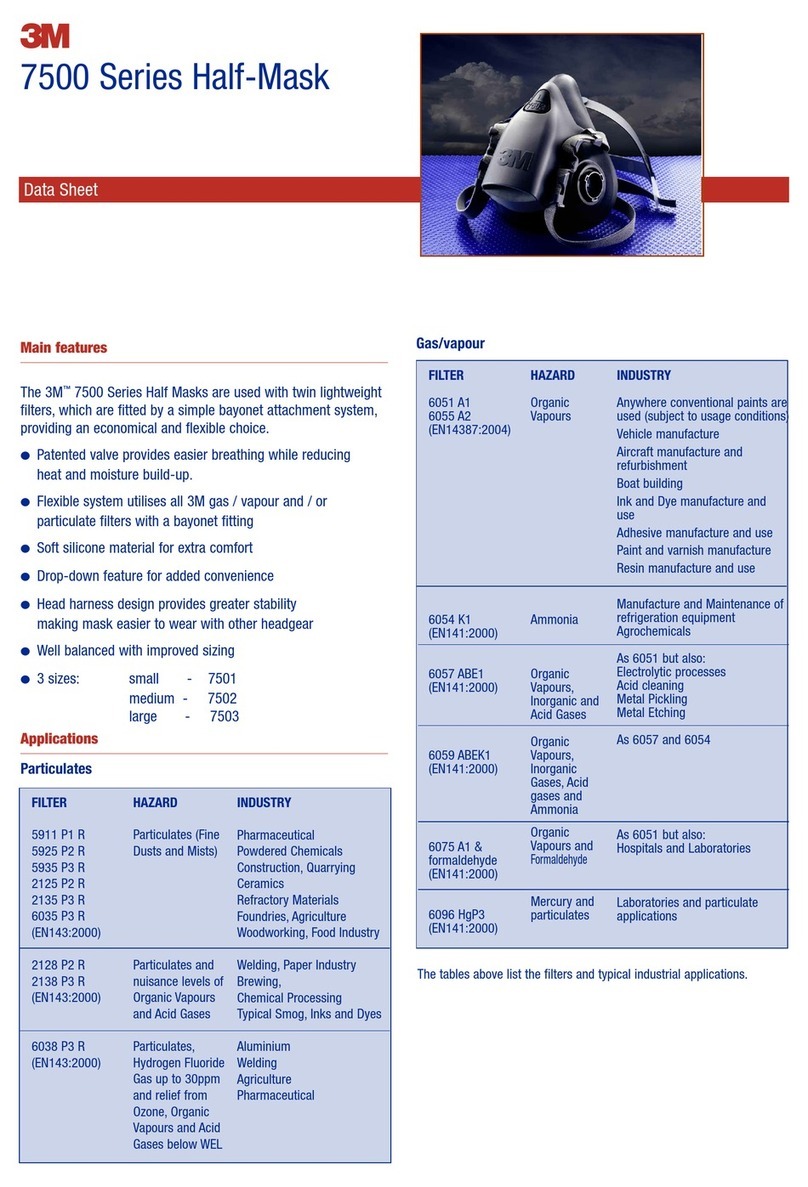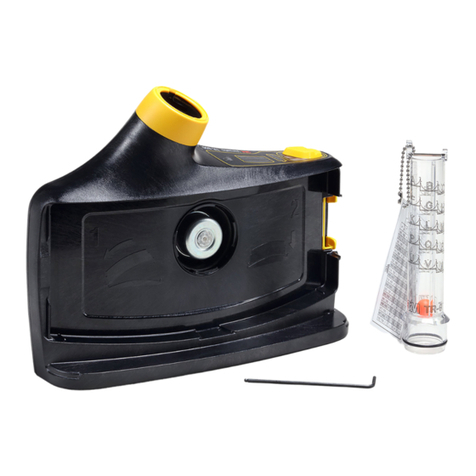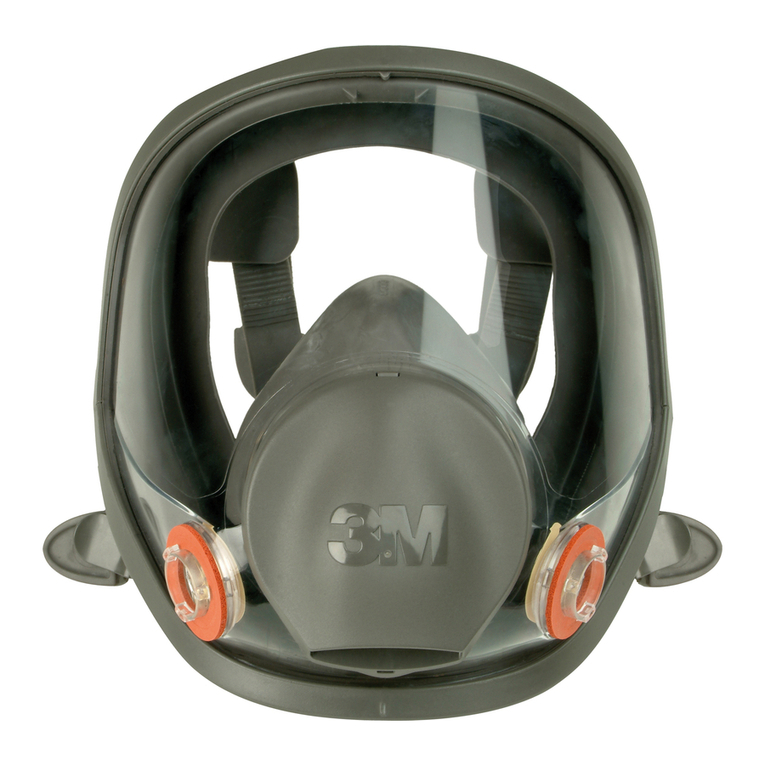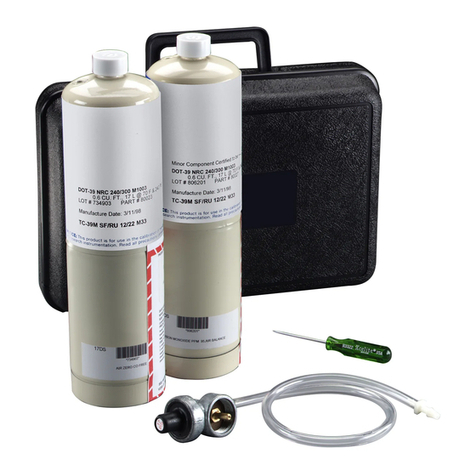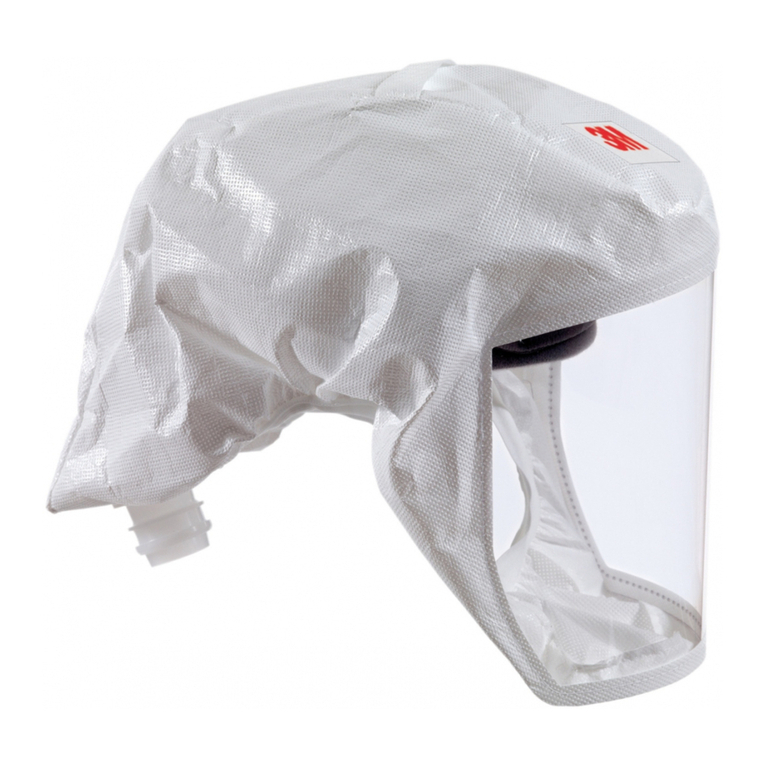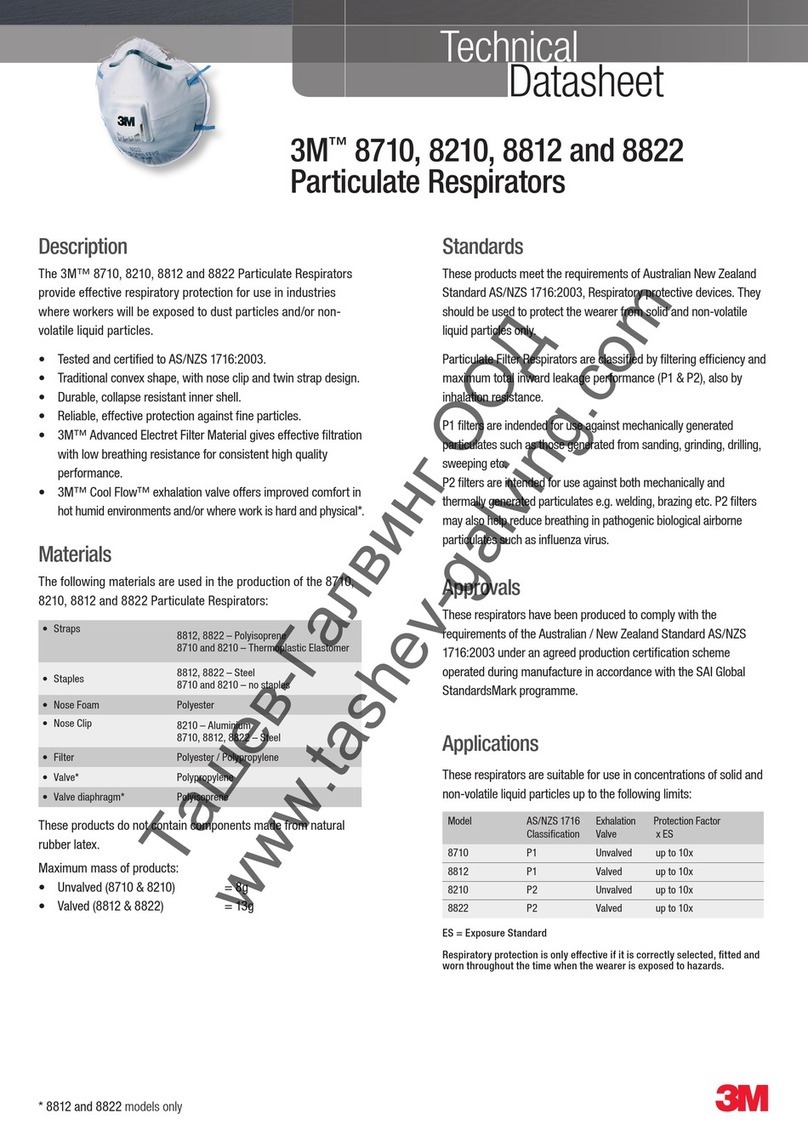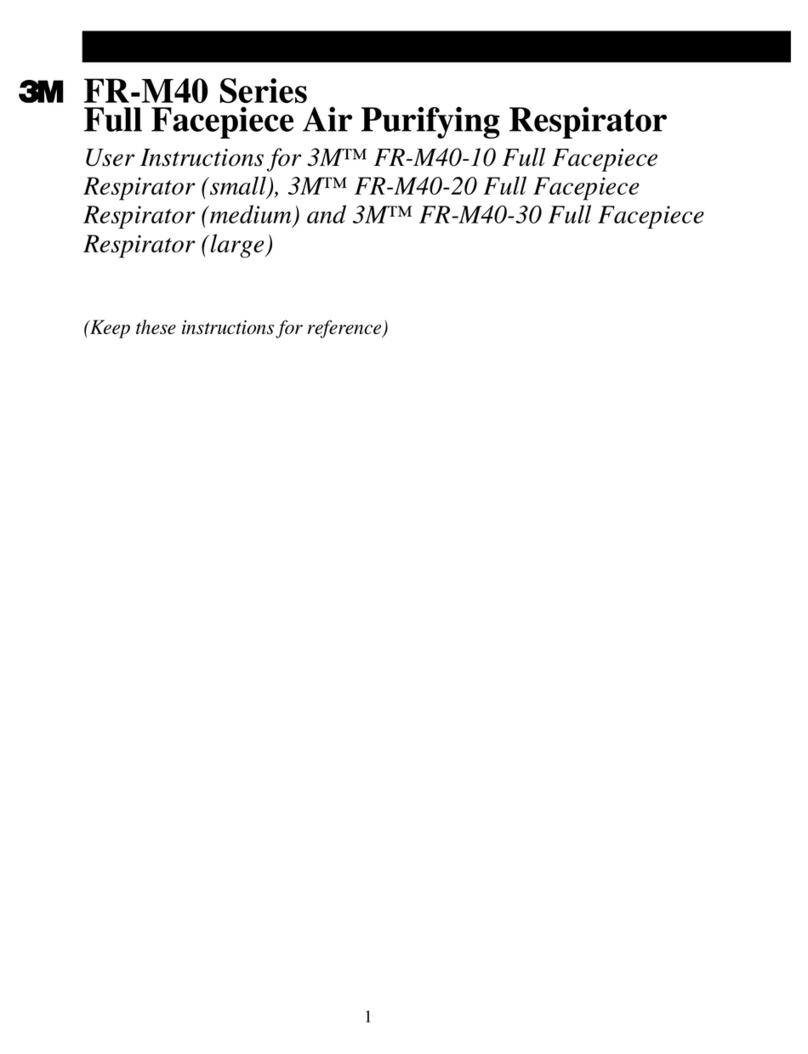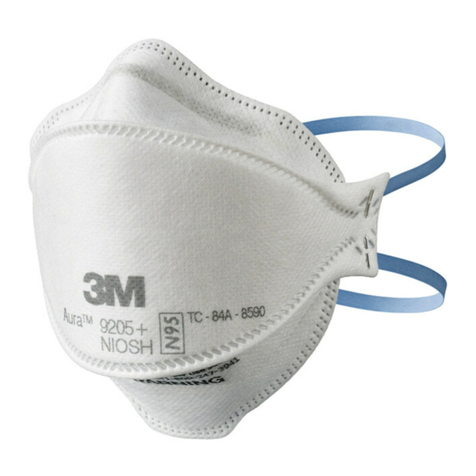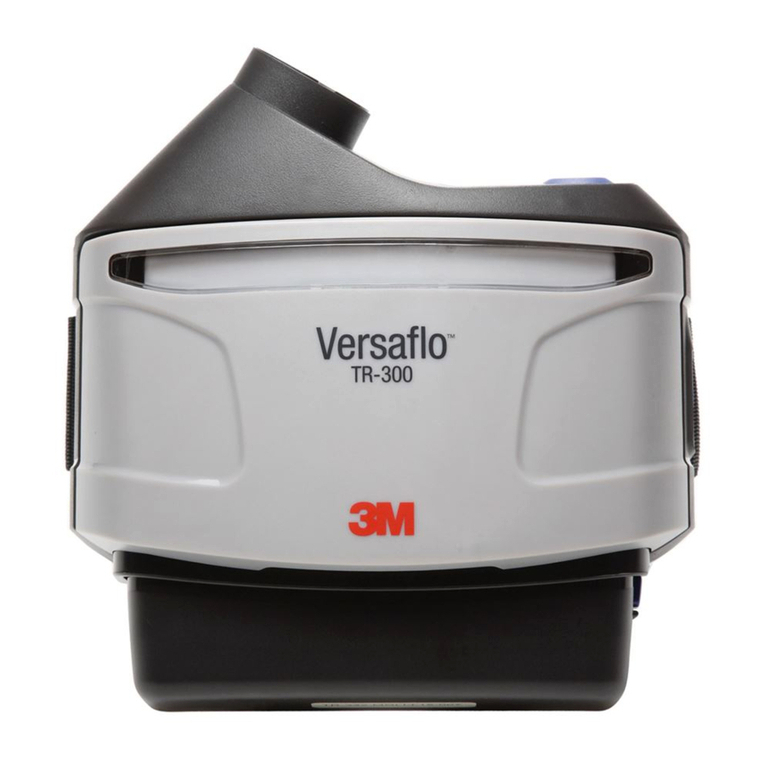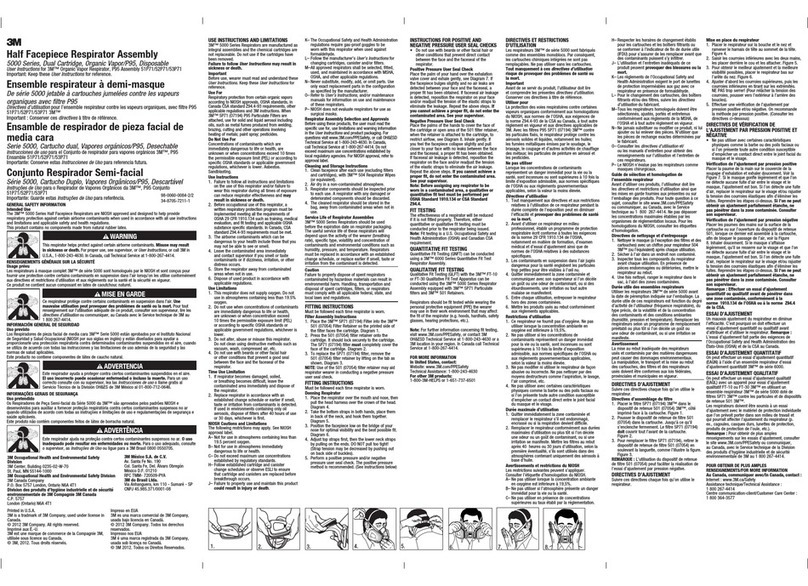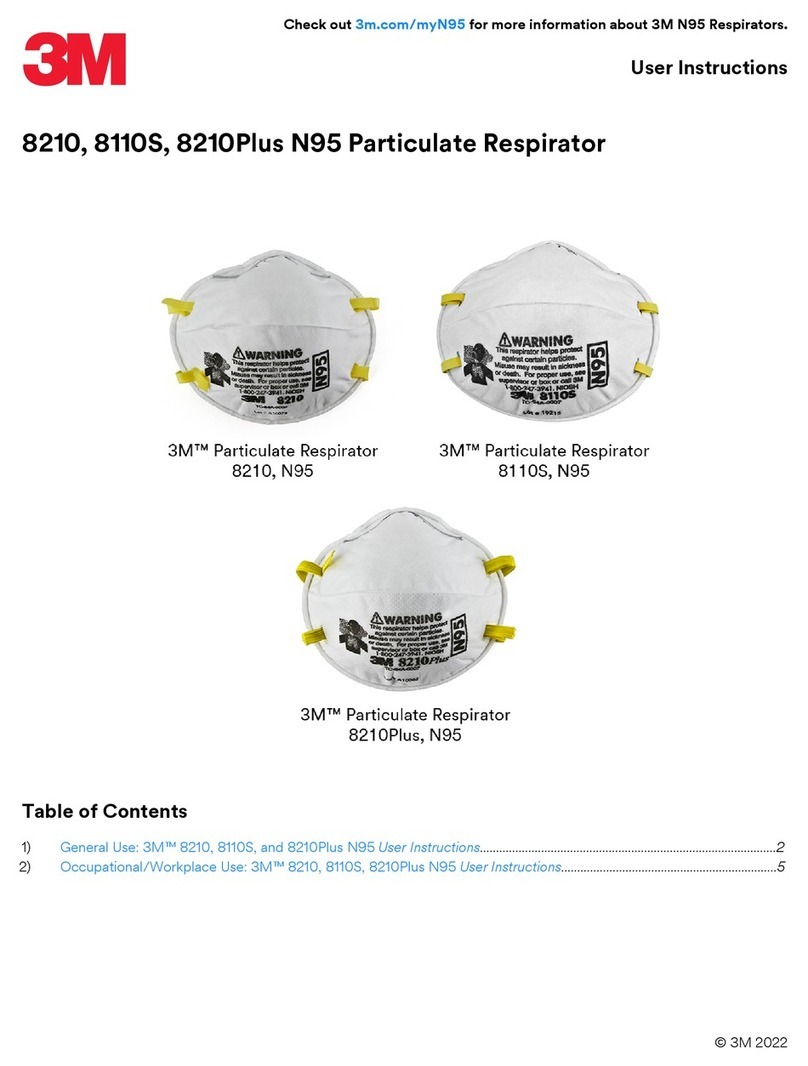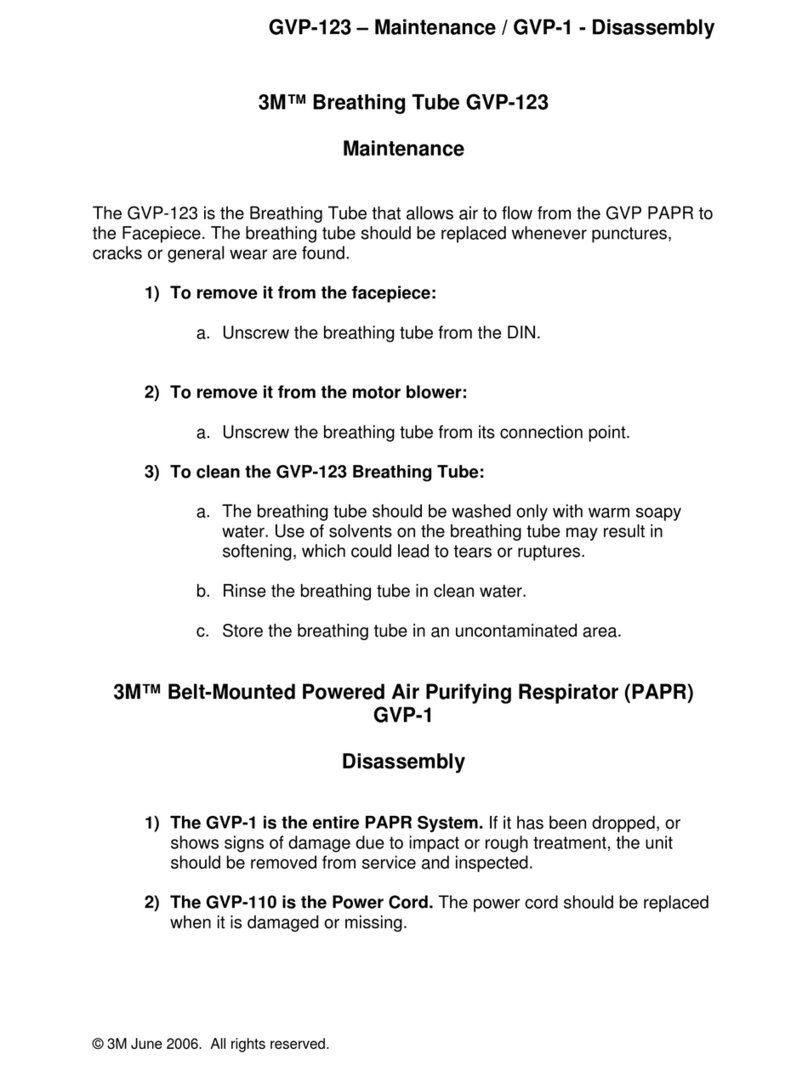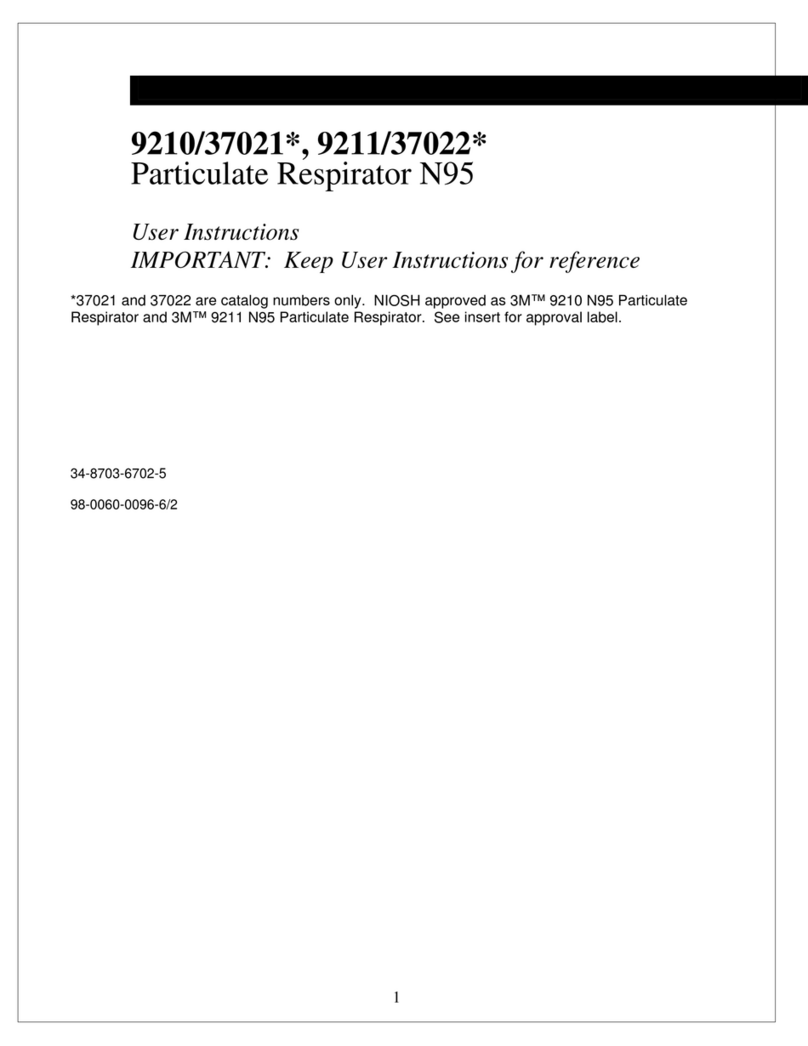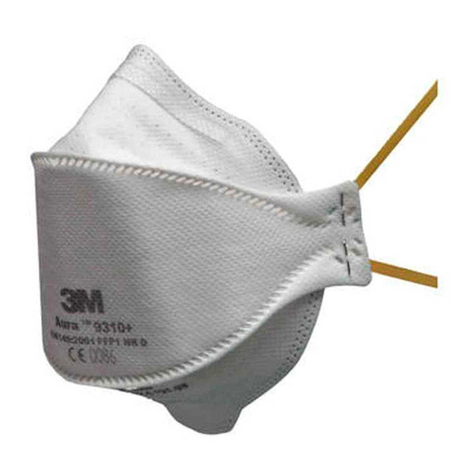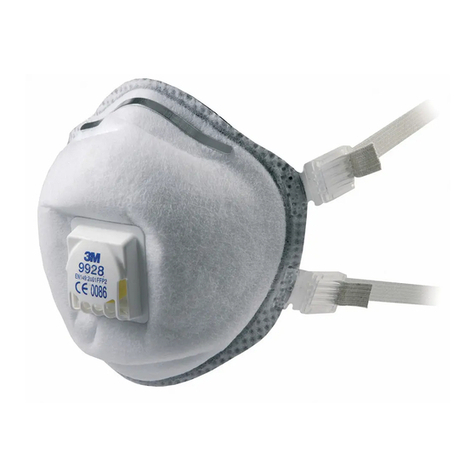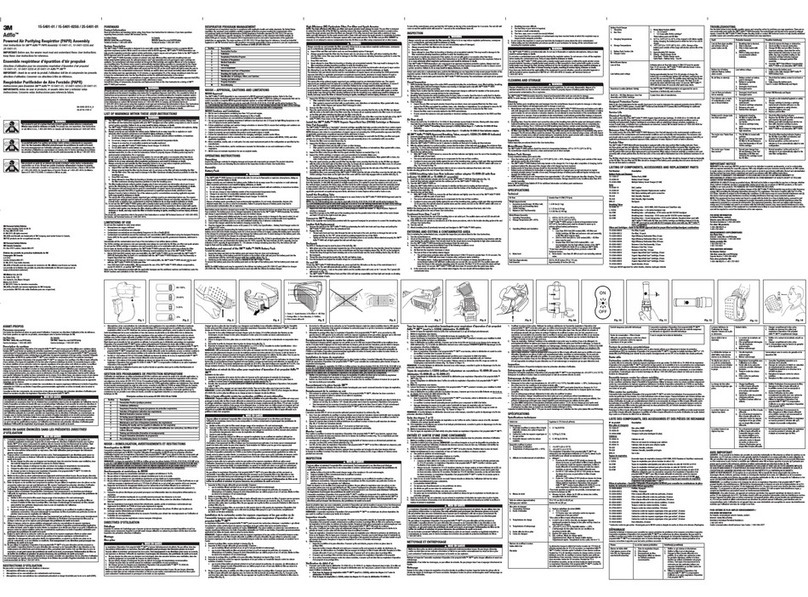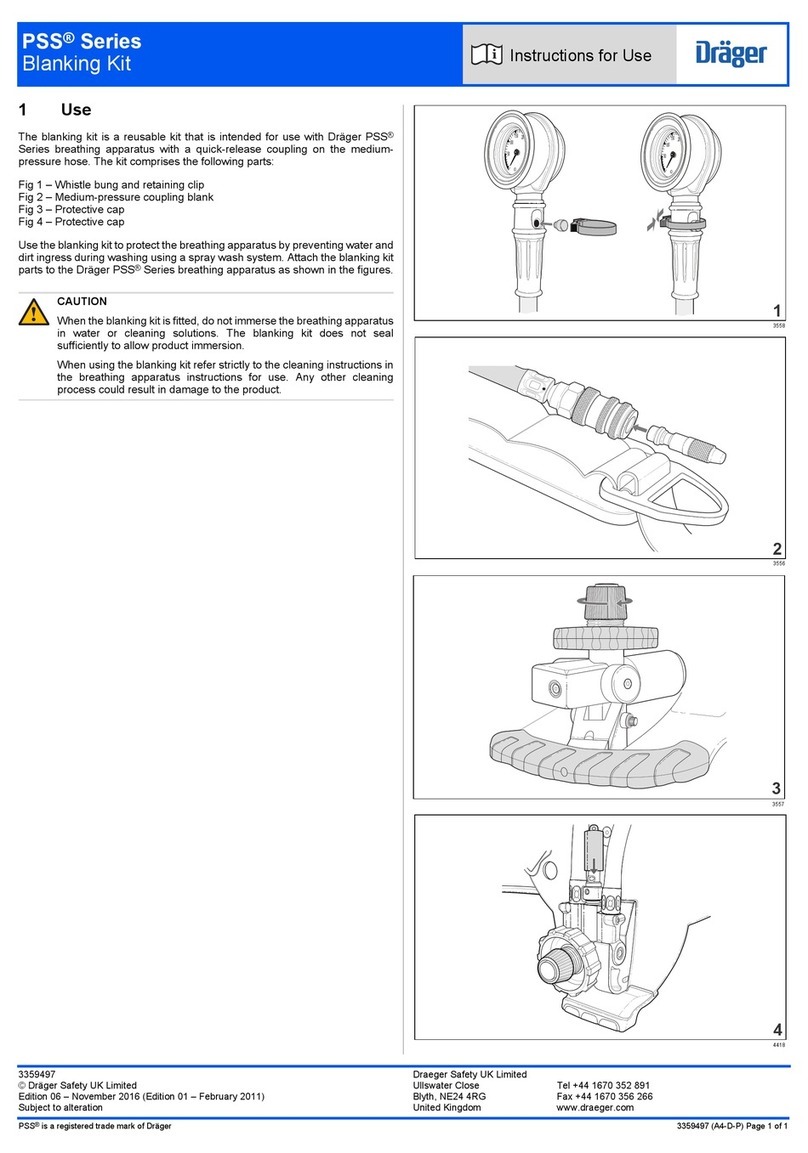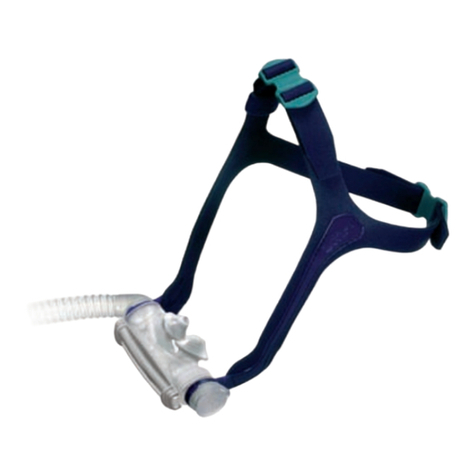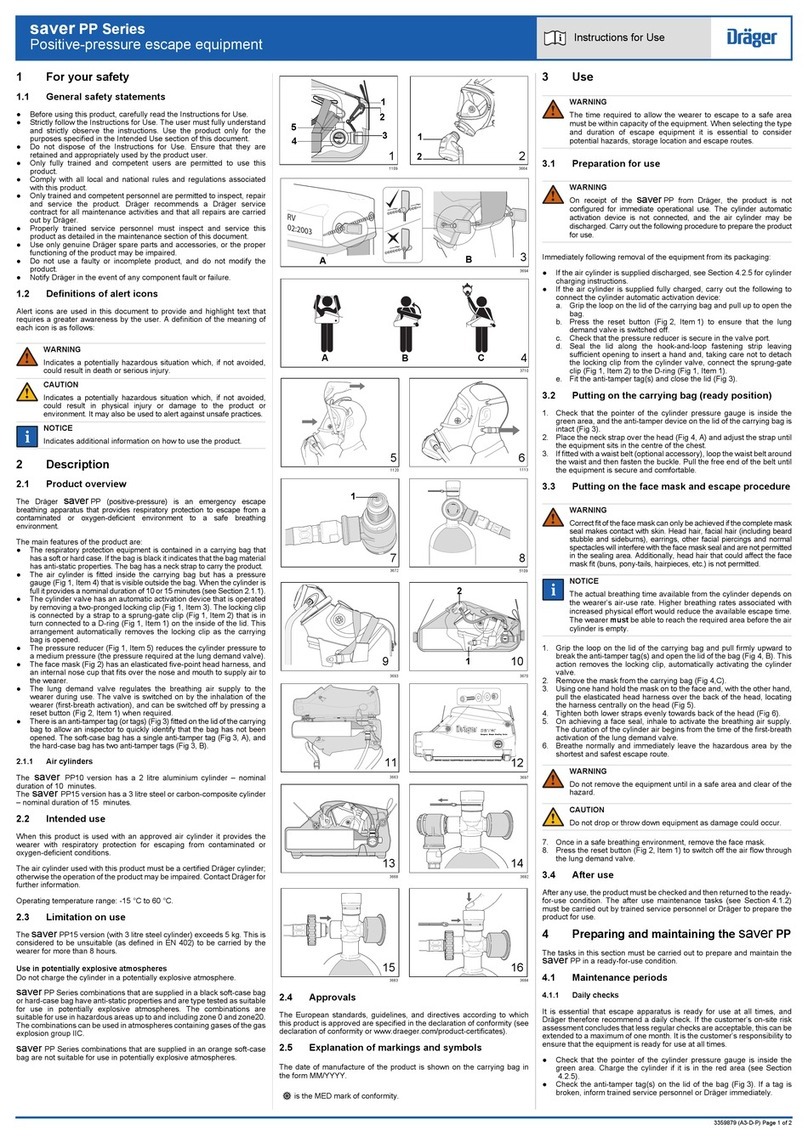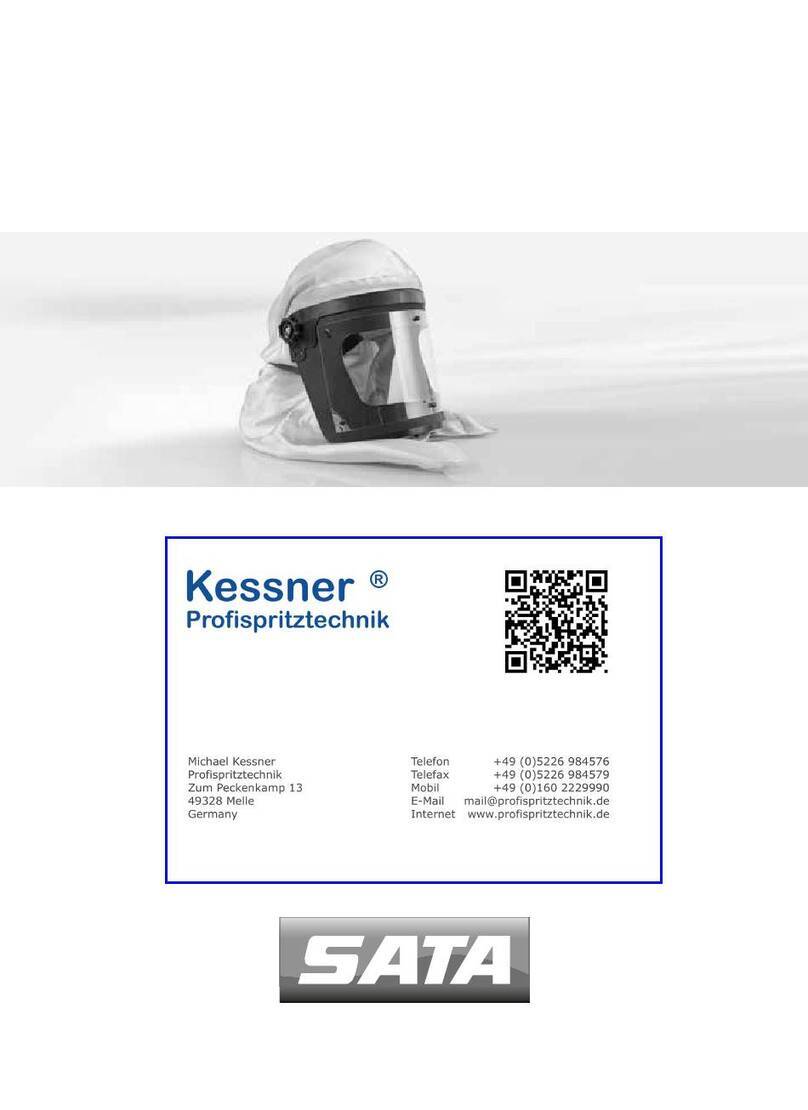
2. If air leakage is detected around the faceseal, reposition respirator on your face and/or readjust tension of
the elastic straps to eliminate leakage. Repeat the user seal check until a proper seal is obtained.
Care must be taken when performing the positive pressure seal check not to exhale too hard. The goal is to
check the seal, not disturb the seal between the facepiece and the face.
If you cannot achieve a proper seal, DO NOT enter contaminated area. See your supervisor.
Negative Pressure User Seal Check with 3M™ Cartridges, 6000 Series
1. Place palms of hands to cover face of cartridge or open area of 3M™ Filter Retainer 501 and inhale
gently (Fig. 19). If you feel the facepiece collapse slightly and pull closer to your face with no leaks
between the face and facepiece, a proper seal has been obtained.
2. If faceseal air leakage is detected, reposition the respirator on your face and/or readjust the tension of the
straps to eliminate leakage and recheck seal.
Be careful not to disturb the respirator seal by pressing too forcefully during negative pressure seal checks.
NOTE: Use of 3M™ Filter Retainer 501 may aid respirator wearer in conducting a negative pressure
user seal check.
Negative Pressure User Seal Check with 3M™ Filters, 2000 series
1. Place your thumbs onto the center portion of the lters, restricting airow into the breathing tube of lters,
and inhale gently (Fig. 20). If you feel facepiece collapse slightly and pull closer to your face with no leaks
between the face and facepiece, a proper seal has been obtained.
2. If faceseal air leakage is detected, reposition respirator on face and/or readjust tension of straps to
eliminate the leakage. Repeat the user seal check until a proper seal is obtained.
Be careful not to disturb the respirator seal by pressing too forcefully during negative pressure seal checks.
Negative Pressure User Seal Check with 3M™ Filters 7093/7093C
1. Using hands squeeze or press lter covers toward facepiece and inhale gently (Fig. 21). If you feel the
facepiece collapse slightly and pull closer to your face with no leaks between the face and facepiece a
proper seal has been obtained.
2. If faceseal air leakage is detected, reposition the respirator on your face and/or readjust the tension of the
straps to eliminate the leakage and recheck seal.
Be careful not to disturb the respirator seal by pressing too forcefully during negative pressure seal checks.
Negative Pressure User Seal Check with 3M™ Dual Airline Respirator
1. If using the 3M™ Breathing Tubes SA-1500 or SA-2500, disconnect airline hose from air control valve.
2. Inhale gently. If you feel facepiece collapse slightly and pull closer to your face with no leaks between the
face and facepiece, a proper seal has been obtained.
3. For Combination Dual Airline where cartridges or lters are attached, perform user seal check as
described above under the appropriate cartridge or lter that is being used.
4. If faceseal air leakage is detected, reposition the respirator on your face and/or readjust the tension of the
straps to eliminate the leakage and recheck seal.
IMPORTANT: If you cannot achieve a proper seal, DO NOT enter the contaminated area. See your
supervisor. Before assigning any respirator to be worn in a contaminated area, a qualitative or
quantitative t test MUST be performed per OSHA Standard 1910.134, CSA Standard Z94.4 or the
Brazil Respiratory Protection Program of the Ministry of Labor.
RESPIRATOR REMOVAL
1. Grasp the bottom straps, at the back of the neck and unhook them.
2. Remove respirator by pulling head harness down from over head. (These two steps can be done in
reverse order if preferred.)
FIT TESTING
The effectiveness of a respirator will be reduced if it is not tted properly. Therefore, either qualitative
or quantitative t testing must be conducted prior to the respirator being used. Fit testing is a U.S.
Occupational Safety and Health Administration (OSHA), a Canadian CSA and a Brazilian BMOL
requirement. Fit testing should be conducted using the heaviest cartridge, canister, lter or combination
that each wearer will use in their work environment. Respirators should also be t tested while wearing any
personal protective equipment (PPE) the wearer may use in their work environment that may affect the t of
the respirator (e.g. hoods, hardhats, hearing protectors, etc.). For further information concerning t testing,
contact 3M PSD Technical Service.
• Quantitative Fit Testing: Quantitative Fit Testing (QNFT) can be conducted using a 3M™ Fit Test Adapter
601 and P100 lters such as the 3M™ Particulate Filters 2091 or 7093.
• Qualitative Fit Testing: Qualitative Fit Testing (QLFT) with the 3M™ Qualitative Fit Test Apparatus FT-10
or FT-30 can be conducted using any of the NIOSH approved Particulate lters.
Entering and Exiting a Contaminated Area
• Airborne contaminants which can be dangerous to your health include those that are so small you may
not be able to see or smell them.
• Always conduct a user seal check before entering a contaminated area.
• Leave the contaminated area immediately if any of the following conditions occur:
° Any part of the respirator becomes damaged.
° Breathing becomes difcult.
° Your feel dizzy or your vision is impaired.
° You taste or smell contaminants.
° Your face, eyes, nose or mouth become(s) irritated.
° You suspect the concentrations of contaminants may have reached levels at which this respirator may
no longer provide adequate protection.
• Do not wear this respirator in areas where:
° Atmospheres are oxygen decient.
° Contaminant concentrations are unknown.
° Contaminant concentrations are Immediately Dangerous to Life or Health (IDLH).
° Contaminant concentrations exceed the Maximum Use Concentration (MUC) determined using the
Assigned Protection Factor (APF) for the specic respirator system or the APF mandated by specic
government standards, whichever is lower.
INSPECTION, CLEANING, AND STORAGE
WWARNING
Failure to follow these instructions may reduce respirator performance, expose you to
contaminants above the OEL, and may result in sickness or death.
• Do not clean respirator with solvents. Cleaning with solvents may degrade some respirator
components and reduce respirator effectiveness.
• Inspect all respirator components before each use to ensure proper operating condition.
Inspection Procedure
This respirator must be inspected before each use and at the time of cleaning to ensure it is in good
operating condition. Any damaged or defective parts must be replaced before use. Do not enter a
contaminated area with damaged or defective parts. The following inspection procedure is recommended.
1. Check facepiece for cracks, tears and dirt. Be certain facepiece, especially faceseal area, is not distorted.
2. Examine inhalation valves for signs of distortion, cracking or tearing.
3. Make sure straps are intact and have good elasticity.
4. Examine all plastic parts for signs of cracking or fatiguing. Ensure bayonet gaskets are in good condition.
5. Remove exhalation valve cover (see Head Harness Assembly & Valve Cover Replacement procedure)
and examine exhalation valve and valve seat for signs of dirt, distortion, cracking or tearing. Replace
exhalation valve cover.
Cleaning and Storage
Cleaning is recommended after each use.
1. Remove cartridges, lters and/or breathing tubes. The exhalation valve cover, exhalation valve and
inhalation valves can also be disassembled if necessary.
2. Clean facepiece (excluding lters and cartridges), by immersing in warm cleaning solution, water
temperature not to exceed 120°F (49°C), and scrub with soft brush until clean. Add neutral detergent if
necessary. Do not use cleaners containing lanolin or other oils.
3. Disinfect facepiece by soaking in a solution of quaternary ammonia disinfectant or sodium hypochlorite
(1 oz. [30 mL] household bleach in 2 gallons [7.5 L] of water), or other disinfectant.
4. Rinse in fresh, warm water and air dry in non-contaminated atmosphere.
5. Respirator components must be inspected prior to each use. A respirator with any damaged or
deteriorated components should be repaired or discarded.
6. The cleaned respirator should be stored away from contaminated areas when not in use.
Specications
Contact 3M Technical Service for technical specications (e.g. weight, materials of construction, etc). This
product contains no components made from natural rubber latex.
Cartridge and Filter Selection and Approvals
Before using any of these products, the user must read and understand the specic Use For, Use Limitations
and Warning information in the cartridge or lter User Instructions and product documentation or call PSD
Technical Service. Do not exceed maximum use concentrations established by local regulatory agencies.
NIOSH Approvals
3M™ Cartridges, 6000 Series
6001
6001i
6002
6003
6004
6005
6006
6009S
60921
60921i
60922
60923
60924
60925
60926
60928*
60929S
Certain Organic Vapors X X X X X X X X X X X
Chlorine X X X X X X X X X
Hydrogen Chloride X X X X X X X
Sulfur Dioxide X X X X X X X X X
Chlorine Dioxide XXXX
Hydrogen Sulde X X X X X X X
Hydrogen Fluoride X X X X X
Formaldehyde X X X X
Ammonia X X X X
Methylamine X X X X
Mercury Vapor X X
P100 Particulate Filter X XXXXXXXX
* 3M recommended for use against methyl bromide or radioiodine up to 5ppm with daily cartridge replacement.
NOTE: Not NIOSH approved for use against methyl bromide or radioiodine.
